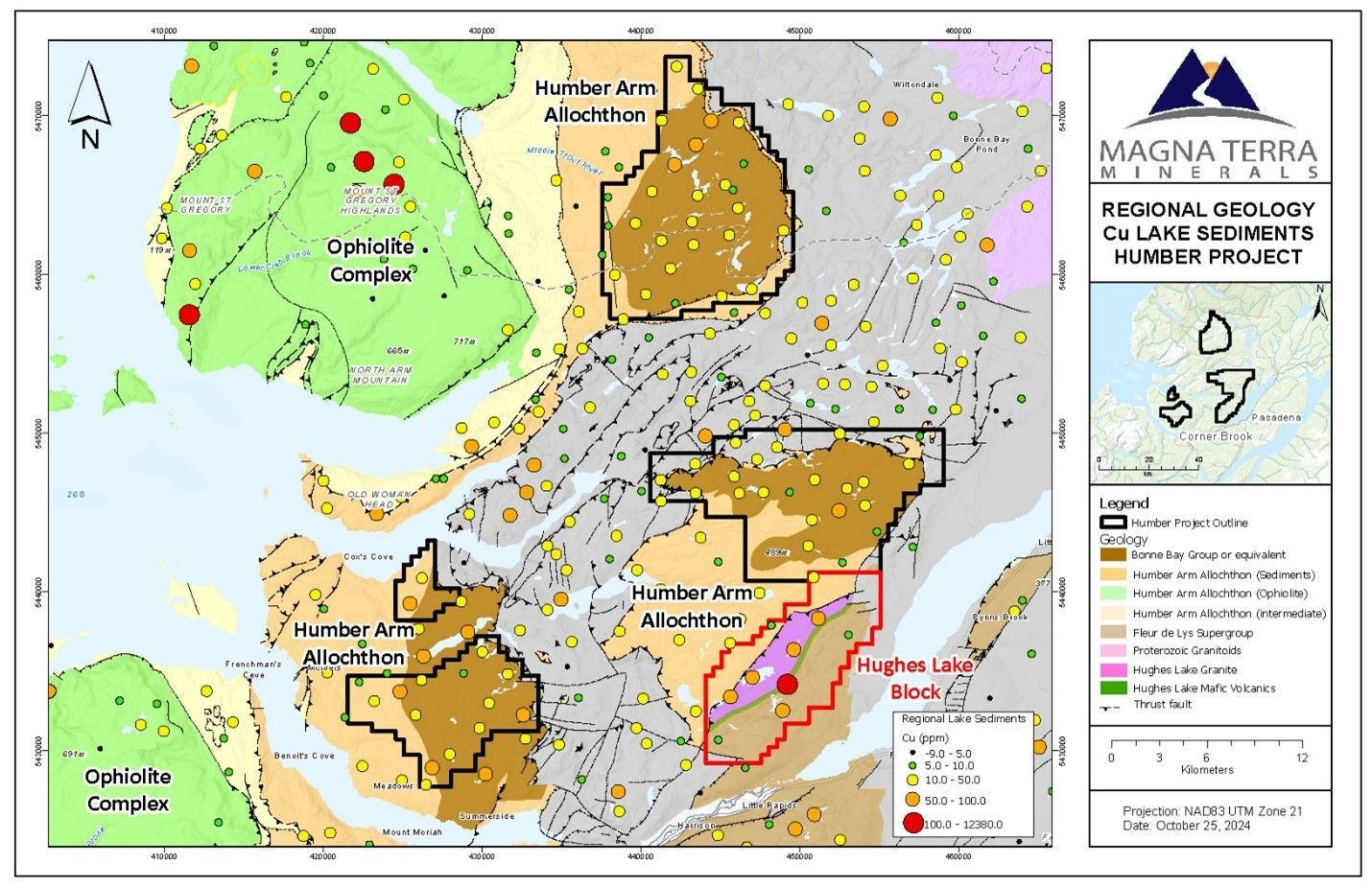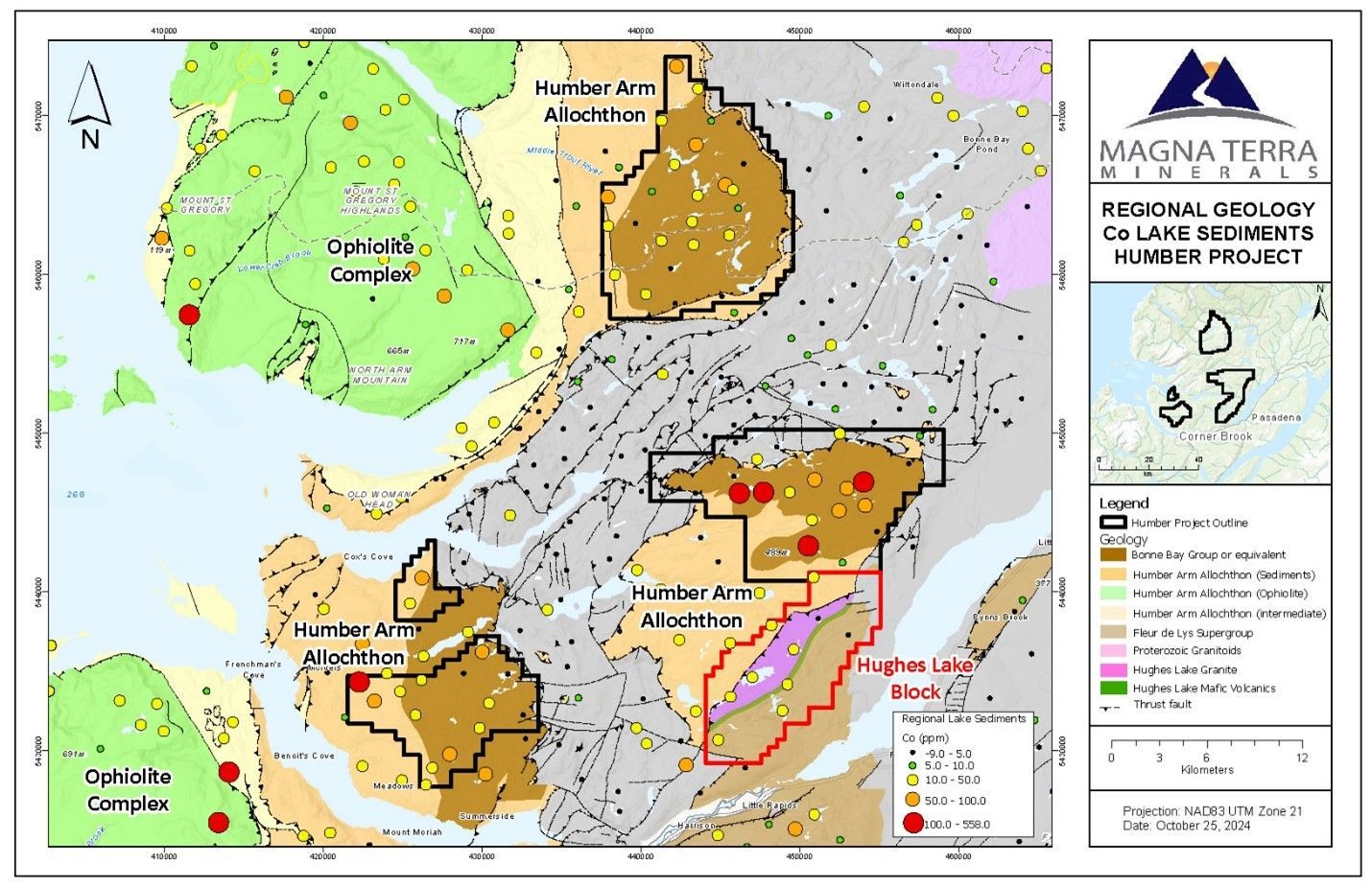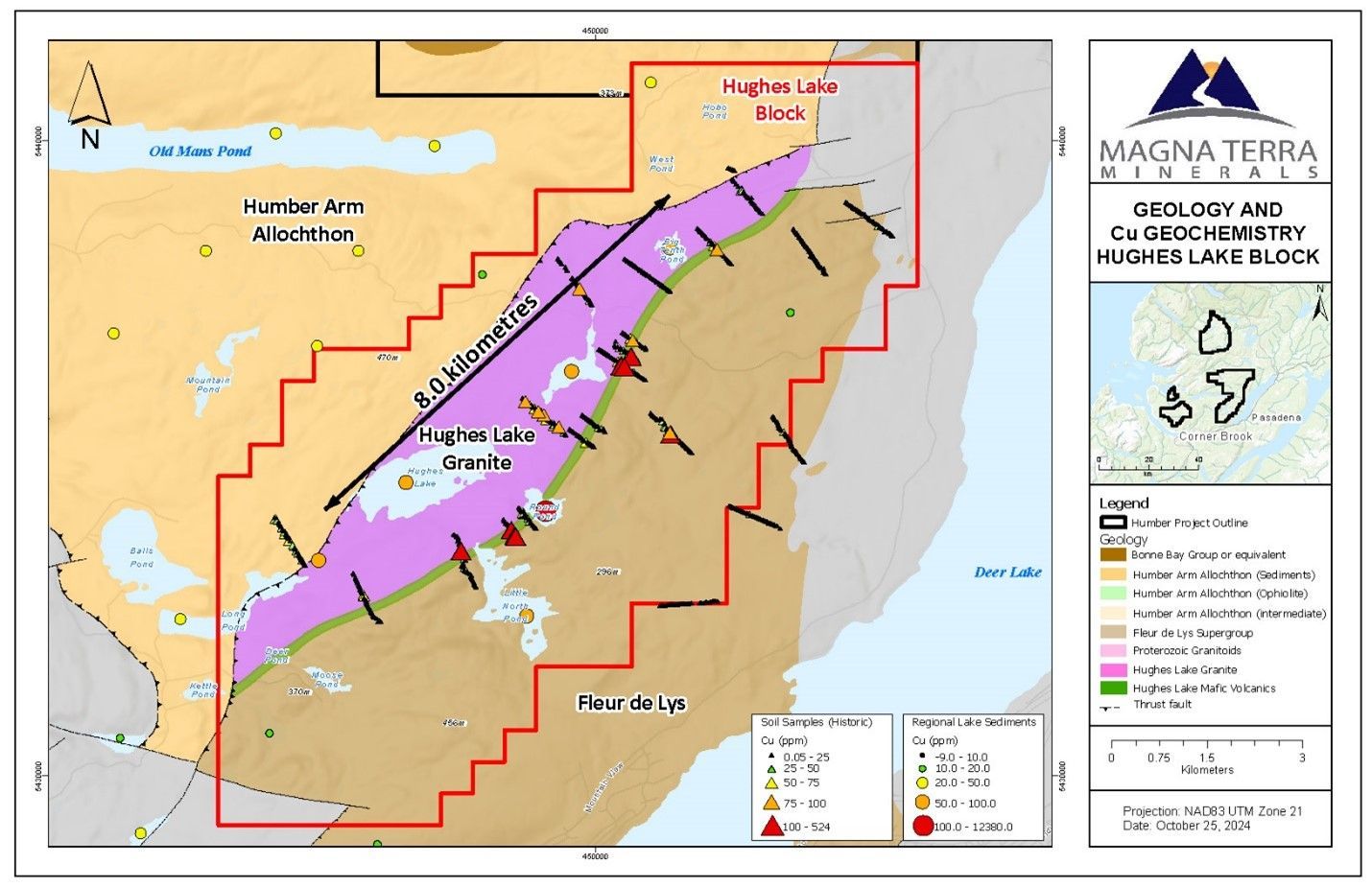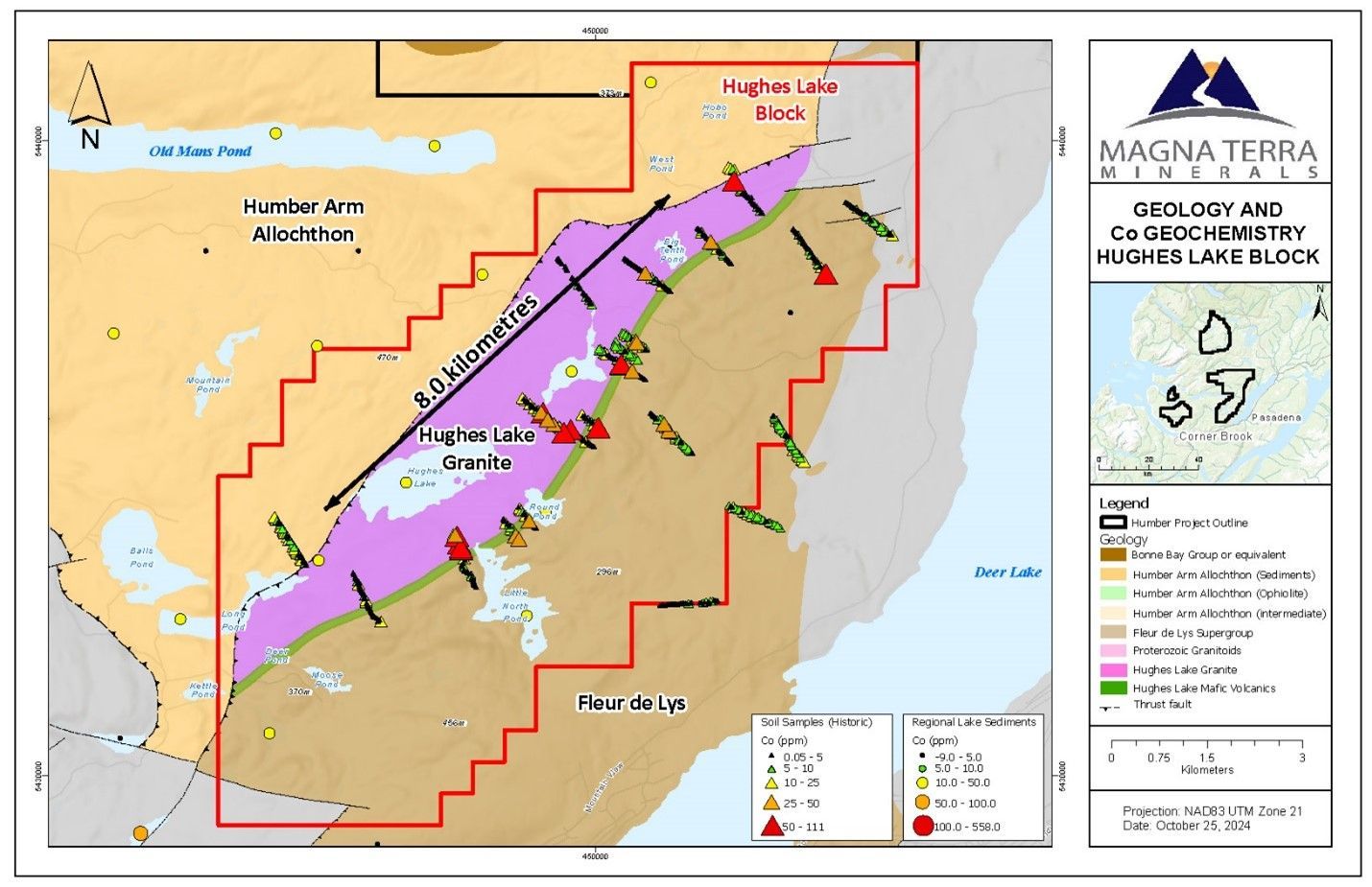+1 (905)-301-9983
Humber Copper Cobalt Project
The Humber Project is an exploration project focused on critical minerals and metals and comprises 1,627 claims in 10 mineral licences covering a total area of 40,675 hectares (Figure 1).
The Project is underlain by rocks of the sedimentary Humber Arm Allochthon and adjacent plutonic and volcanic Hughes Lake Complex, which are host to coincident anomalous copper (Cu), cobalt (Co), lead (Pb), silver (Ag), molybdenum (Mo), gold (Au), arsenic (As), and antimony (Sb) lake sediment values (Figures 1 and 2). This metal signature and geological environment is supportive of the area being host to Sediment-hosted Stratiform Copper (SSC) Deposits. SSC Deposits host 60% of global Cobalt production^ and 20% of global Copper production* in deposits such as the Central African Copper Belt, which is thought to be analogous to the geological setting of the Humber Copper-Cobalt Project. The exploration potential is also underscored by the presence of base metal deposits nearby including the York Harbour and Daniels Harbour Deposits located at lower stratigraphic levels of the region.
The Hughes Lake Trend is defined by an 8 km long anomalous zone of copper and cobalt in soil samples that is coincident with mafic volcanic rocks of the Hughes Lake Complex and associated magnetic rocks. Importantly, historic soil samples** assay up to 524 ppm Copper with 17 of 646 (2.6 %) samples assaying >75 ppm Copper and 33 of 646 (5%) samples assaying >50 ppm. Soil samples** assay up to 111 ppm Cobalt with 12 of 646 (1.8%) samples assaying > 50 ppm Cobalt and 26 of 646 samples (4%) assaying > 25 ppm Cobalt (Figures 3 and 4).
Project Highlights
- Potential for discovery of significant Cu-Co deposits;
- Host to regionally anomalous Cu, Co, Ag, Pb +/- Au, Mo, As, and Sb lake sediments;
- 8+ km Hughes Lake Copper-Cobalt Trend;
- Analogous to the Kalahari Copper Belt, Namibia and Botswana; Central African Copper Belt, Zambia and the Democratic Republic of Congo (DRC); and the Kupferschiefer Belt, Poland;
- Globally, these Sediment-hosted Stratiform Copper (“SSC”) deposit types represent 20% of Cu production* and 60% of Co production^;
- District scale land package now comprising 40,675 hectares;
- Located within the top-tier mining jurisdiction of Newfoundland and Labrador;
- Year-round accessibility with road access to the majority of the Project;
- First mover advantage in a previously unrecognized area of exploration potential; and
- Acquired through staking – cost effective acquisition and no underlying royalties or option payments.
Project Geology
The Project is underlain by sedimentary rocks of the Humber Zone of the Newfoundland Appalachians, more particularly the Ordovician-aged Humber Arm Allochthon Allochthon; a section of shelf sediments that have been accreted (thrust) onto Precambrian Grenville basement (Long Range Massif) and associated Late Cambrian to Middle Ordovician carbonate (and related rocks) sediments of the St. George, Port au Port and Table Head groups (Williams et al., 1983; Knight, 1994). The Humber Project is specifically underlain by rocks of the Bonne Bay Group or equivalents. The rocks of the Humber Arm Allochthon have been variably deformed and metamorphosed which are known to create favourable deposition environments for these deposit types.
The Hughes Lake Trend is underlain by Neo-Proterozoic to Cambrian-aged plutonic and volcanic Hughes Lake Complex that are in fault contact with the adjacent Humber Arm allochthon (Figure 1).
Lake Sediment Geochemistry and Global Analogues
The Project is centred on a series of anomalous lake sediment samples (Davenport et al., 1996) that show regionally elevated levels of Co (up to 160 ppm), Ag (up to 0.6 ppm), Pb (up to 84 ppm), Cu (up to 99 ppm), As (up to 142 ppm), Mo (up to 15 ppm), and Au (up to 10 ppb) (Figures 1 and 2). An analysis of the lake geochemical data via Principal Component Analysis has indicated that the metal suite present within the Project area is likely related to a black shale source, as many of the anomalous lake sediments have low-Ni values which precludes association with the nearby ophiolite complexes to the immediate west.
This geochemical signature (Cu, Co, Ag, Pb +/- Au, Mo, As, Sb), and spatially associated geology of the Bonne Bay Group and equivalent, is supportive of the area hosting SSC Deposits similar to other Sedimentary Hosted Cu-Co Deposits globally. SSC Deposits have long been an important, but often overlooked, source of copper representing 20% of global Cu Production*; 2nd most behind Porphyry Cu Deposits, 60% of global Co production^ and the fourth largest source of Ag*. SSC Deposits are often laterally continuous along bedding and contain consistent grades (1.2 to 5% Cu)* and large resources of by-product Au, U, platinum-group, and rare-earth elements.
Humber Project Location and Acquisition
The Humber Project covers three separate licence blocks (Blocks 1, 2, and 3) of that are located 31, 45 and 11 kilometres north of Corner Brook, NL on NTS Map Sheets 12H/04, 12H/05 and 12G/01, respectively. The Project is accessible by a network of gravel and logging roads that extend from provincial highways (HWY 430 at Deer Lake, HWY 431 at Wiltondale, and HWY 440 at Hughes Brook and Cox's Cove). The Humber Project is an early-stage conceptual exploration project located in western Newfoundland focused on critical minerals and metals.
*https://www.geologyforinvestors.com/sediment-hosted-stratiform-copper-deposits-the-future-of-copper-and-cobalt-mining/
^Petavratzi, E, Gunn, G, Kresse, C. (2019). Commodity review: Cobalt. British Geological Survey.
**(Galloper Gold Corp.; Fage, 2022)
Technical Reports and Documentation Notes
This technical content of this website has been reviewed and approved by David A. Copeland, P. Geo., Chief Geologist with Signal Gold Inc., a "Qualified Person", under National Instrument 43-101 - Standard for Disclosure for Mineral Projects.
All quoted soil and lake sediment samples results were compiled from historic assessment and government reports obtained from the government of Newfoundland and Labrador. The Qualified Person has not completed sufficient work to validate these historic results.
Figure 1:
A map showing the Humber Project with underlying geology of the Humber Arm Allochthon and coincident anomalous Cu lake sediment samples
Figure 2:
A map showing the Humber Project with underlying geology of the Humber Arm Allochthon and coincident anomalous Co lake sediment samples.
Figure 3:
A map showing the geology, lake sediment samples (Cu-ppm) and reconnaissance soil samples (Cu-ppm) outlining an 8-kilometre long trend along the Hughes Lake mafic volcanics, Humber Project.
Figure 4: A map showing the geology, lake sediment samples (Co-ppm) and reconnaissance soil samples (Co-ppm) outlining an 8-kilometre long trend along the Hughes Lake mafic volcanics, Humber Project.






